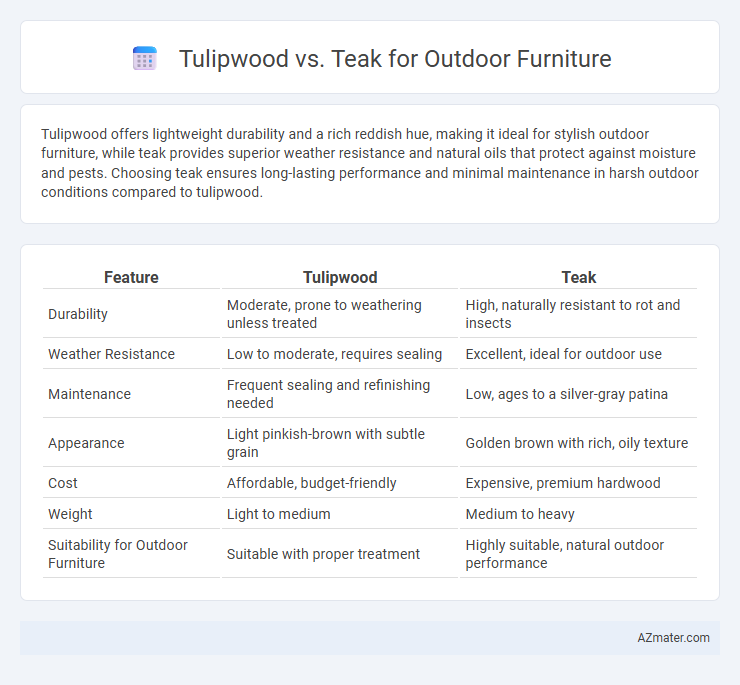Tulipwood offers lightweight durability and a rich reddish hue, making it ideal for stylish outdoor furniture, while teak provides superior weather resistance and natural oils that protect against moisture and pests. Choosing teak ensures long-lasting performance and minimal maintenance in harsh outdoor conditions compared to tulipwood.
Table of Comparison
| Feature | Tulipwood | Teak |
|---|---|---|
| Durability | Moderate, prone to weathering unless treated | High, naturally resistant to rot and insects |
| Weather Resistance | Low to moderate, requires sealing | Excellent, ideal for outdoor use |
| Maintenance | Frequent sealing and refinishing needed | Low, ages to a silver-gray patina |
| Appearance | Light pinkish-brown with subtle grain | Golden brown with rich, oily texture |
| Cost | Affordable, budget-friendly | Expensive, premium hardwood |
| Weight | Light to medium | Medium to heavy |
| Suitability for Outdoor Furniture | Suitable with proper treatment | Highly suitable, natural outdoor performance |
Introduction: Comparing Tulipwood and Teak for Outdoor Furniture
Tulipwood and teak offer distinct advantages for outdoor furniture, with tulipwood prized for its light color, smooth grain, and affordability, while teak is renowned for its exceptional durability, natural oils, and resistance to weather and decay. Teak's high oil content provides superior protection against moisture and insects, making it a top choice for long-lasting outdoor use. Tulipwood requires proper sealing and maintenance to withstand outdoor conditions, but offers an attractive, lightweight alternative for stylish yet budget-friendly furniture.
Wood Density and Durability: Tulipwood vs Teak
Tulipwood has a wood density of approximately 560 kg/m3, making it lighter but less dense than teak, which measures around 670 kg/m3. Teak is renowned for its exceptional durability and natural resistance to rot, insects, and weathering, outperforming tulipwood in outdoor environments. The higher density and oily grain of teak contribute significantly to its longevity and minimal maintenance requirements for outdoor furniture compared to tulipwood.
Weather Resistance: Which Withstands the Elements Better?
Tulipwood, known for its moderate durability, resists weather to some extent but is less resilient compared to teak when exposed to outdoor elements. Teak contains natural oils that provide exceptional weather resistance, making it highly durable against moisture, UV rays, and temperature fluctuations. For long-lasting outdoor furniture, teak outperforms tulipwood by maintaining structural integrity and appearance under harsh weather conditions.
Appearance and Aesthetic Appeal
Tulipwood offers a striking appearance with its rich reddish hues and subtle grain patterns, creating a warm and vibrant aesthetic ideal for outdoor furniture. Teak boasts a classic golden-brown color that gracefully weathers to a sophisticated silver-gray patina over time, enhancing its timeless charm. Both woods provide unique visual appeal, with tulipwood delivering bold color contrast and teak offering long-lasting elegance.
Maintenance Requirements and Longevity
Tulipwood offers a lightweight, affordable option for outdoor furniture but requires regular sealing and protection from moisture to prevent warping and decay. Teak boasts natural oils that provide excellent resistance to water, pests, and rot, significantly reducing maintenance needs while enhancing longevity up to 50 years or more. Choosing teak ensures durable, low-maintenance outdoor furniture that withstands harsh weather conditions better than tulipwood.
Cost Comparison: Budgeting for Tulipwood or Teak
Tulipwood offers a more budget-friendly option for outdoor furniture, typically costing 30-50% less than teak, making it ideal for those seeking durability without a premium price. Teak's higher cost reflects its superior natural oils and resistance to weather, often priced between $25 to $50 per board foot compared to tulipwood's $15 to $30. Budgeting for teak requires accounting for long-term investment benefits like minimal maintenance and longevity, while tulipwood demands regular sealing to maintain appearance and durability.
Environmental Impact and Sustainability
Tulipwood offers a sustainable alternative to teak by sourcing from fast-growing, plantation-managed trees that reduce deforestation pressures. Teak, while durable and weather-resistant, often comes from tropical forests where illegal logging and habitat destruction pose significant environmental concerns. Choosing certified tulipwood or responsibly harvested teak with FSC certification ensures outdoor furniture supports sustainable forestry and minimizes ecological footprints.
Weight, Handling, and Ease of Construction
Tulipwood is lighter than teak, making outdoor furniture easier to move and handle, especially for larger pieces or frequent rearranging. Teak's natural oils contribute to its durability but increase its weight, which can make handling more challenging yet offers superior resistance to weathering. Tulipwood is easier to work with and shape due to its softer grain, while teak requires specialized tools and experience for cutting and construction because of its density and hardness.
Suitability for Outdoor Furniture Styles and Designs
Tulipwood offers a light, smooth grain ideal for modern and minimalist outdoor furniture designs, while teak's rich, warm tones and natural oils provide superior durability suited for traditional and rustic styles. Teak's high resistance to moisture, insects, and decay makes it a top choice for long-lasting, weather-resistant outdoor pieces. Tulipwood requires regular sealing to maintain its appearance and durability, making it better suited for covered or less exposed outdoor environments.
Conclusion: Choosing the Right Wood for Outdoor Furniture
Tulipwood offers a lightweight and affordable option with moderate durability, best suited for sheltered outdoor areas, while teak stands out for its exceptional strength, natural oils, and resistance to weather and pests, making it ideal for long-lasting outdoor furniture. Teak's high oil content ensures minimal maintenance and superior longevity compared to tulipwood, which may require additional sealing and care to withstand outdoor conditions. For outdoor furniture that combines durability, weather resistance, and aesthetic appeal, teak is the preferred choice despite its higher cost.

Infographic: Tulipwood vs Teak for Outdoor Furniture
 azmater.com
azmater.com